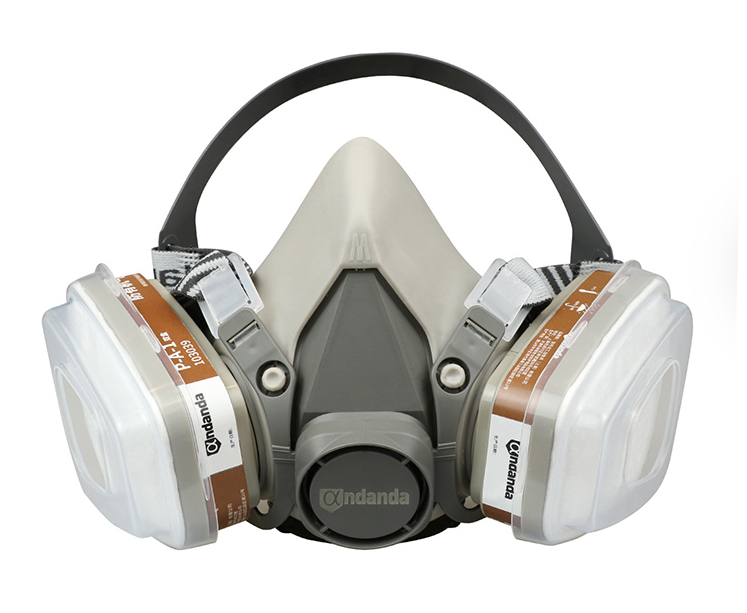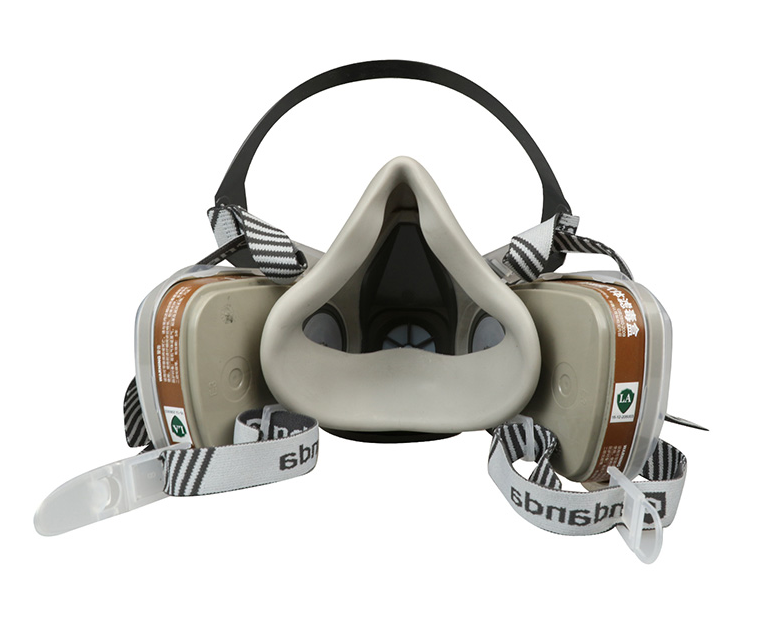Dual Defense: Enhancing Safety with Combination Cartridges in Light Series Respirators
Combination cartridges are integrated filters designed for use in respiratory protective equipment, combining multiple layers to filter out both particulate matter and gases or vapors. They are crucial in environments where workers are exposed to hazardous substances, providing essential respiratory protection by purifying inhaled air from chemical, biological, particulate, or other dangers. Specifically, when used with a light series half-face respirator body, these cartridges offer a balanced, lightweight protective solution. The half-face respirator covers the nose, mouth, and chin, and is compatible with various combination cartridges tailored to specific hazards, ensuring adaptability and comprehensive protection in diverse working conditions. This configuration not only maximizes safety but also enhances comfort and ease of movement, making it suitable for prolonged use in industries ranging from healthcare to construction and chemical handling.

Understanding Light Series Respirators
Definition and Types
Light series half-face respirators are personal protective equipment designed to cover the nose, mouth, and chin, providing respiratory protection against hazardous atmospheres. These respirators are typically equipped with two cartridges, offering flexibility in filter selection to match specific environmental threats. They are distinguished by their lightweight design, ease of use, and compatibility with a range of combination cartridges tailored to filter particulates, gases, and vapors simultaneously.
Common Applications
Light series respirators are versatile and widely used across various industries, including coal mining, chemical, transportation, construction, electronics, communication, commerce, home furnishing, medical treatment, petrochemical, oil and gas, pharmacy, automobile, glass manufacturing, and cement. Their adaptability and protective capabilities make them essential in environments where airborne pollutants pose a risk to health and safety.
New TPE Materials; Face Fitting Design; Lightweight, Anti-Aging
The latest innovations in light series respirators include the use of new Thermoplastic Elastomers (TPE) materials. These materials offer enhanced durability and flexibility, ensuring a snug, comfortable fit that adapts to different face shapes, thus minimizing leaks and increasing the effectiveness of the respirator. TPE materials are lightweight and exhibit superior anti-aging properties, extending the lifespan of the respirator under various environmental conditions.

Introduction to Combination Cartridges
Definition and Purpose
Combination cartridges are designed for use with half-face and full-face respirators, protecting against multiple types of airborne hazards. They combine layers of filtering material and chemical sorbents to protect against particulates, gases, and vapors simultaneously. This integrated approach ensures comprehensive protection in environments where workers may be exposed to a variety of contaminants.
Components and Design
Combination cartridges typically consist of a particulate filter and an activated carbon layer. The particulate filter captures physical particles like dust, mists, and fumes, while the activated carbon layer adsorbs gases and vapors. The design may also include a pre-filter to extend the life of the primary filter by capturing larger particles.
Advantages over Single-Purpose Cartridges
The primary advantage of combination cartridges is their multifunctional protection, eliminating the need for multiple, single-purpose cartridges. This not only simplifies inventory management but also reduces the weight and bulkiness of the respirator, enhancing wearer comfort. Furthermore, combination cartridges are cost-effective and efficient, offering broad-spectrum protection in a single, easy-to-use component.
Enhanced Safety Features of Combination Cartridges
Multi-Gas Protection
Combination cartridges are equipped to handle multiple gas and vapor hazards simultaneously, providing a broad range of chemical protection. This is particularly beneficial in industries where workers are exposed to complex mixtures of chemicals, ensuring safety without the need to switch cartridges frequently.
Particulate Filtration Capabilities
In addition to gas and vapor protection, combination cartridges effectively filter out particulate matter, including dust, mists, and fumes. This dual function is critical in environments with both particulate and chemical hazards, providing comprehensive respiratory protection.
Improved Comfort and Usability
Advancements in combination cartridge design focus on improving wearer comfort and usability. Lightweight materials, ergonomic shapes, and balanced configurations reduce fatigue and allow for longer wear times. Additionally, the easy-to-install design of these cartridges simplifies maintenance and replacement, ensuring that workers can quickly adapt to changing environmental conditions without compromising protection.
Selection and Maintenance Considerations
Factors to Consider When Choosing Combination Cartridges
When selecting combination cartridges for respiratory protection, it’s essential to consider the specific contaminants present in the workplace, their concentration levels, and the required protection factor. The physical and chemical properties of the contaminants, such as boiling point and toxicity, also play a crucial role in cartridge selection. Additionally, the compatibility of the cartridges with the respirator model and the potential need for additional protective features, such as nuisance odor relief, should be evaluated.
Proper Storage and Handling Procedures
Combination cartridges should be stored in a cool, dry place, away from contaminants, sunlight, extreme temperatures, and moisture, to preserve their effectiveness. Original packaging should be used to prevent damage and contamination. Handling procedures should emphasize minimizing exposure to the elements and avoiding physical damage that could compromise the cartridge’s integrity.
Maintenance and Replacement Guidelines
Regular inspection and maintenance are critical to ensure the effective performance of combination cartridges. Users should follow the manufacturer’s guidelines for cleaning and storing respirators and cartridges. Cartridges should be replaced according to the manufacturer’s recommendations, or sooner if they become damaged, or clogged, or if the wearer detects taste or smell breakthrough.
Regulatory Compliance and Standards
Overview of Relevant Regulations
In the United States, the Occupational Safety and Health Administration (OSHA) and the National Institute for Occupational Safety and Health (NIOSH) are the primary regulatory bodies governing respiratory protection standards. OSHA sets and enforces safety standards in the workplace, while NIOSH certifies respiratory protective devices, including combination cartridges, ensuring they meet established performance criteria.
Compliance Requirements for Combination Cartridges
For a combination cartridge to be compliant, it must meet specific performance standards set by regulatory bodies. This includes certification for particulate filtration efficiency, gas and vapor absorption capacity, and resistance to airflow. Compliance also involves adherence to labeling and instruction requirements, ensuring users are informed about the cartridge’s capabilities and limitations.
Importance of Certification and Testing
Certification and rigorous testing are crucial to verify that combination cartridges provide adequate protection against identified hazards. Certified equipment assures users of its quality, reliability, and safety. Employers and workers must ensure that the respiratory protection used meets the required standards and is appropriate for the specific conditions of their work environment.
Future Trends and Developments
Emerging Technologies in Respiratory Protection
The future of respiratory protection is likely to see advancements in smart technologies, such as wearables that monitor air quality and cartridge saturation in real time, alerting users to potential hazards and when to replace cartridges. Innovations in materials science could also lead to cartridges with enhanced filtration efficiency and longer life spans.
Potential Advancements in Combination Cartridge Design
Advancements may include the development of more compact, lightweight cartridges offering equal or improved protection. New absorbent materials and filter technologies could enhance the removal of a broader range of contaminants, including nanoparticles and emerging chemical hazards, while also improving breathability.
Implications for Workplace Safety
These advancements promise to significantly improve workplace safety by providing more effective, user-friendly respiratory protection. Enhanced protection capabilities, combined with real-time monitoring, could lead to a reduction in respiratory-related illnesses and injuries. Additionally, the development of more adaptable and efficient respiratory solutions could encourage greater compliance among workers, further enhancing safety outcomes.
Final Words
Enhancing workplace safety through the use of combination cartridges in light series respirators represents a significant stride in protecting workers from a myriad of airborne hazards. These advanced respiratory solutions offer a multifaceted defense against particulates, gases, and vapors, ensuring comprehensive protection in diverse industrial environments. The emphasis on selection, maintenance, and adherence to regulatory compliance further amplifies their effectiveness. As technology evolves, future advancements in cartridge design and materials promise to elevate protection levels, comfort, and usability. Ultimately, the integration of combination cartridges into light series respirators underscores a commitment to safeguarding worker health and fostering safer workspaces, setting a new standard in respiratory protection and occupational safety.